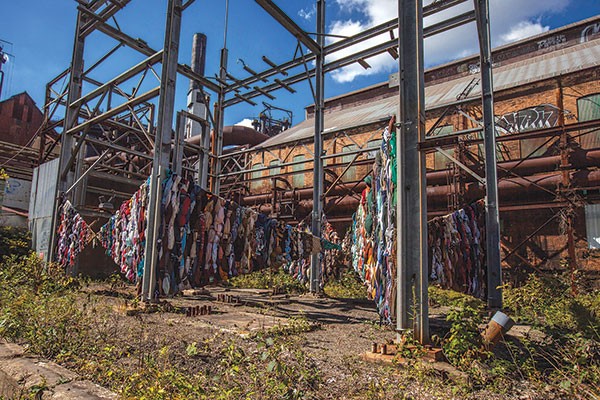Though artists have by no means given up on the semi-domestic, semi-corporate spaces of gallery and museum, it's no longer surprising for an art exhibit to be presented in a locale such as a park or an abandoned prison. But it's still refreshing, especially when there's synergy between location and artwork, which usually means the art has to have been produced for the site. In this regard, Alloy: Pittsburgh is both ambitious and thoroughly executed.
Carrie Furnaces National Historic Landmark is the hulking ruin in Rankin, the remains of seven furnaces that once stood there, employing up to 5,000 people. Now, under the laudable stewardship of Rivers of Steel National Heritage Area, the site is an important component of the group's mission to maintain an awareness of Pittsburgh's once-vital steel industry, with an emphasis on the lives of the workers that made that industry possible. Art-wise, Carrie Furnaces are best known for the still-standing "Carrie Deer," a 1997 guerrilla-art project created when the area was strictly off limits, which brought a lot of attention to the site and helped pave the way for Alloy: Pittsburgh.
Organized by Chris McGinnis and Sean Derry, with support from Indiana University of Pennsylvania's Kipp Gallery, Alloy: Pittsburgh strove to foster relevance of the artwork to the site: Participating artists did research and attended lectures led by historians, artists and landscape architects. Each of the resulting 13 art projects engages with the site and its history, though in ways not always apparent. In this regard, artists' statements posted throughout are helpful. (Access to the exhibit is possible on just one more day, Sat., Oct. 26, as part of Rivers of Steel's regular seasonal site tour that day; tickets are $15-25.)
Many of the projects engage with the site through contrast, which is not surprising given that the structure is indomitable in its size, industrial form and rusted texture. Anika Hirt's "Scale-Space-BLObs" — short for "Blast furnace Light Object blob"— nestles masses of billowing golden fabric in the labyrinthine core of the mill, with the wrinkled foil introducing a softening presence. Will Schlough's "Ball Machine" positions brightly colored beach balls in a network of existing tracks, repurposing them as stationary pieces of a giant inoperable game.
Literally playful was Emily Sciulli's "Taconite Bounce," which transformed a material-handling mechanism into an interactive game complete with targets, while for the performance "Return of the Spirit of Molten Iron," Dan Wilcox played off the "alien" landscape, attired in a homemade astronaut's suit as he performed various tasks including playing a handmade musical instrument.
The site inspired some diverse and unexpected responses. In the grand interior of the engine house, Carl Bajandas's "Museum of Imaginary Flight," inspired by thoughts regarding success and failure in the steel industry, suspended from the joists large mock-ups of "failed" early experiments with flight. (Full disclosure: Bajandras is a grad student in a class I'm teaching at Carnegie Mellon University.) Anna Mikolay's "The Colored Line" hung an expanse of tarps along the perimeter fence at the entrance, their colors symbolizing the components of steel while signaling the vitality brought to the site by the art projects. In Amber Niedomys' performance "Capture. Settle. Build.," a crew of five constructed a brick-and-salt-block structure that is an ode to transience, and which might not make it through the month.
Some artists chose to emphasize particular aspects of the site. Kyla Groat's "My Lover, The Machine," which highlights the water-filled chamber under the mill, features a wall of water-filled mason jars and a sculpted aquatic figure. Meghan Olson and Kara Skylling's "Tracing," a minimalist installation in the depths of the mill, creates a rhythm of geometric forms to echo the ceaseless rhythm of the work once done there. For "Inexhaustible Residence," Michelle Colbaugh planted ferns to reference non-native species sprouting throughout the site, while watering them with rainwater directed through a sculptural system of tubes.
Hidden histories were reclaimed. "paradox, 1901," by Laurie Barnes, uses a bed-form filled with objects associated with domesticity to allude to the off-site homes and spouses of the workers. Edith Abeyta's "How We Slowly Become History" features masses of colorful, richly textured clothing woven into triangular forms to connect architecture and industry, time and memory, and human presence. Faced with the scale of the mill, Ryan Keene's strategy was to contrast through small scale, with miniature vignettes in "Sketches: Production" positioned throughout the core of the mill. Depicting families stalked by wolves, it's a profound riff on a history fading from awareness, namely, of the pressures resulting from the demand for the ceaseless production that was Carrie Furnaces' reason for being.
















